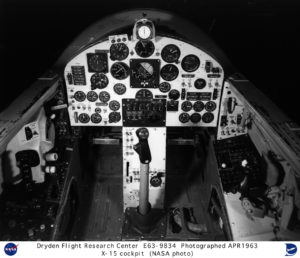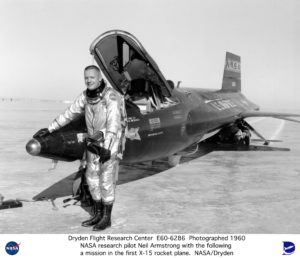From This Day in Aviation History by Brian R. Swopes, thisdayinaviationhistory.com
20 April 1962: “Neil’s Cross-Country.” NASA Research Test Pilot Neil Alden Armstrong conducts a flight to test the Minneapolis-Honeywell MH-96 flight control system installed in the third North American Aviation X-15, serial number 56-6672. The new system combined both aerodynamic and reaction thruster flight controls in one hand controller rather than the two used in X-15s -670 and -671, simplifying the tasks for the pilot.

On its fourth flight, -672 was air-dropped from the Boeing NB-52B Stratofortress drop ship, Balls )8, over Mud Lake, Nevada. Armstrong fired the Reaction Motors XLR99-RM-1 engine and let it burn for 82.4 seconds. The X-15 accelerated to Mach 5.31 (3,789 miles per hour/6,098 kilometers per hour). After the engine was shut down, the rocketplane continued to its peak altitude on a ballistic trajectory, reaching 207,500 feet (63,246 meters) before going over the top and beginning its descent back toward the atmosphere. The test of the new flight-control system went well.
Neil Armstrong began to pull out of the descent at about 100,000 feet (30,480 meters), but the X-15 “ricocheted” off the top of the atmosphere and climbed back to 115,000 feet (35,052 meters) where the aerodynamic control surfaces could not function. He used the reaction thrusters to turn toward the dry lake landing area at Edwards Air Force Base, but although the X-15 rolled into a left bank, it would not change direction and still in ballistic flight, went zooming by Edwards at Mach 3 and 100,000 feet in a 90° left bank.
As the X-15 dropped back into the atmosphere, Armstrong was finally able to get it slowed down, but he was far south of his planned landing site. By the time he got -672 turned around he was 45 miles (72.4 kilometers) to the south, over the Rose Bowl in Pasadena, and gliding through 45,000 feet (13,716 meters). There was real doubt that he would be able to make the X-15 stretch its glide to reach the dry lake.
In a masterful display of airmanship, Neil Armstrong was able to get the X-15 to reach the south end of the dry lake, 12 miles (19.3 kilometers) from the planned landing spot to the north. But it was a very close call. In the debriefing, the pilots of the four F-104 chase planes were asked how much clearance Armstrong had as he crossed over the Joshua trees at the edge of the lake bed. One of them answered, “Oh, at least 100 feet—on either side.”
 At 12 minutes, 28.7 seconds, this was the longest flight of the entire X-15 program. It is called “Neil’s cross-country flight.”
At 12 minutes, 28.7 seconds, this was the longest flight of the entire X-15 program. It is called “Neil’s cross-country flight.”
